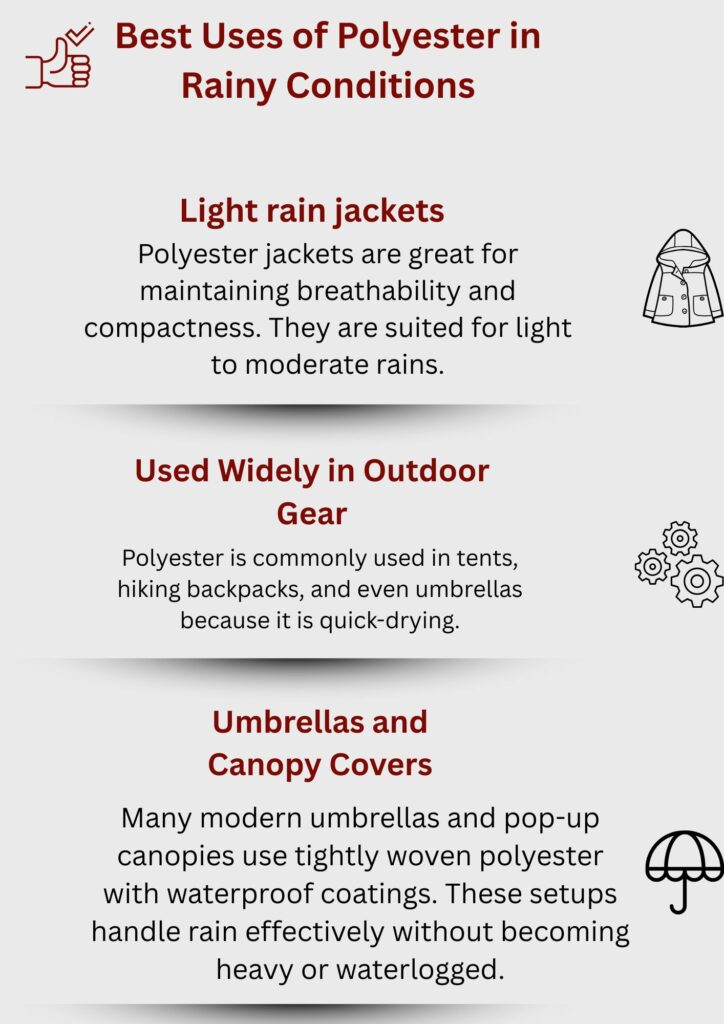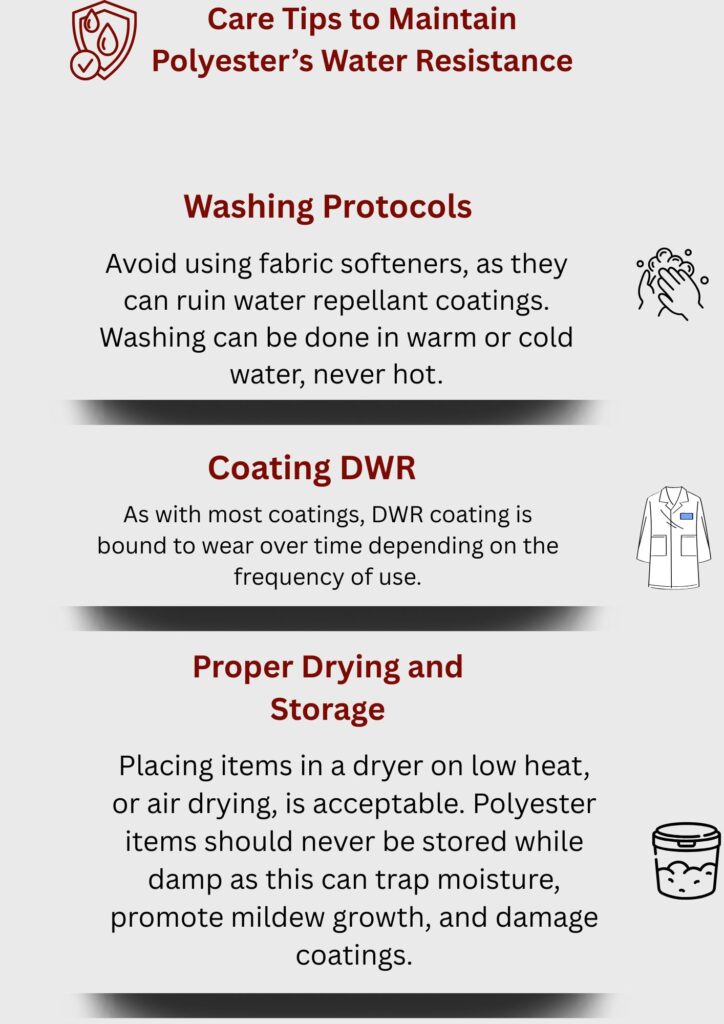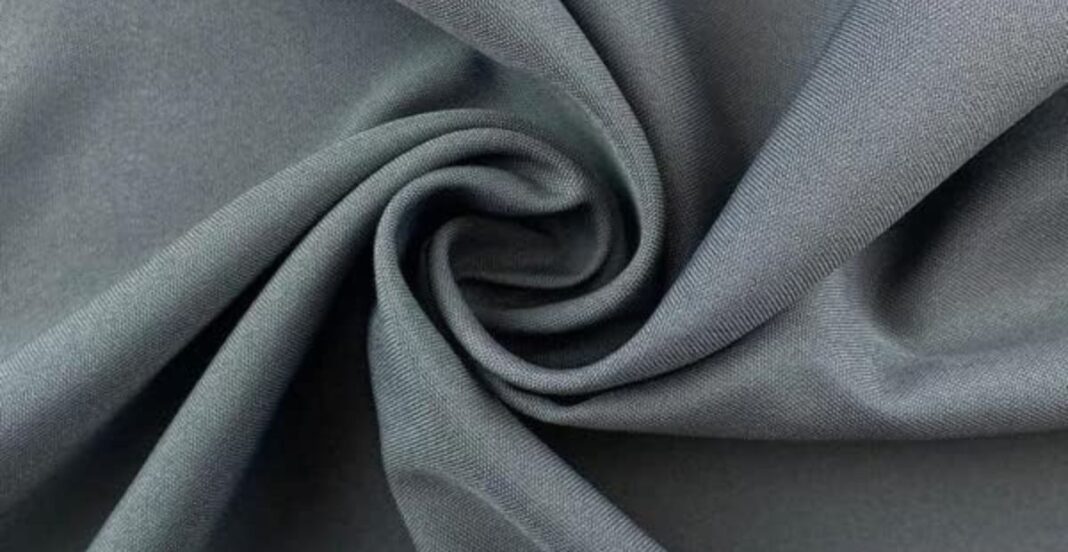Introduction
Polyester ranks among the most popular synthetic fabrics in the globe. It is found in garments, home accessories, as well as in sporting goods. It is well-known for being durable, inexpensive, and simple to maintain. However, when it concerns polyester’s water resistance, one question remains: is polyester rain proof?
Polyester certainly keeps water at bay more than some natural fibers, such as cotton. Its synthetic nature and tight weave structure helps it provide some degree of protection from water. However, in the case of polyester, water interactions are more complex than the initial covering it offers.
Polyester’s application in various weather-resistant goods is mainly due to its hydrophobic properties: its fibers do not absorb water. Still, just like with natural materials, being hydrophobic does not mean it cannot absorb water. We’ll delve into this issue below.
Polyester fabrics have often been classified as ‘waterproof’ or ‘water-resistant’. Yet, before answering ‘is polyester rain proof’, it’s important to address the difference between the two, as they are often confused for one another in the field of clothing and attire.
Is Polyester Waterproof or Water-Resistant? Understanding the Key Difference
Waterproof fabrics prevent water from permeating them, irrespective of the amount of water falling on them. Water-resistant fabrics, on the other hand, offer protection from water to a certain extent, but not entirely.
Waterproof vs. Water-Resistant: Know the Difference
Water-resistant fabrics such as polyester offer Limited waterproofing. External conditions such as the weave density and the surface treatments done on the polyester influence its capacity to repel water. Untreated polyester fabrics only offer protection from light rain and only for short durations.
To answer the query posed—is polyester rain proof?—the response is no. Untreated polyester is not able to provide effective protection from rain. Waterproofing treatments can be applied to polyester to enhance its water resistance capabilities.
How Does Polyester Handle Rain?
When exposed to gentle drizzle, polyester materials can protect from soaking for some duration. Water to some extent, is able to coat polyester surfaces and is beaded, allowing some protection. Polyester fabrics with these fibres provide surface protection for a short duration.
Effective for Light Showers, But Not Torrential Rain
Maintenance of fabric is vital for longer wear-time, effective during light rain, but not torrential rainfall
Certain other polyester fabrics such as waterproof jackets and umbrellas canopies offer protection during drizzle and light rain.
With very heavy rain, water starts to penetrate through the fabric seams as well and ultimately get saturated. If untreated, polyester fabric does not keep user dry for the prolonged duration, which need additional treatments or linings.
Factors Affecting Polyester’s Rain Resistance
There are specific factors that influence how well polyester functions when exposed to rain. This will be summarized.
Fabric Density (Denier Count)
Denier is used to describe the weight of polyester fibers. Each filaments (polyester threads) is thicker with higher denier counts having a greater weight. Higher denier counts fabrics (for example, 210D or 600D) outperform polyester fabrics with lower denier counts in protecting against rain exposure.
Coatings and Treatments
Polyester can be treated with coatings of polyurethane (PU), polyvinyl chloride (PVC), or a durable water repellent (DWR). These polyester coatings serve to protect the fabric from excessive water exposure and improve the fabric’s function in wet conditions.
Weave Type
A tightly woven fabric has a reduced possibility of allowing water ingress. Loosely knitted polyester fabrics like mesh or jersey are poor rain barriers, while more tightly woven variants outperform these in moisture protection.
All these factors will aid in the functions of polyesters while exposed to rain. Without the addition of coatings and layers, these fabrics will not provide complete waterproofing.
Polyester vs. Other Rainproof Fabrics: Which is Best?
To better evaluate whether polyester is rainproof, it may be compared with other, more popular waterproof fabrics.
Polyester vs. Nylon
Both nylon and polyester are synthetic materials. However, nylon is stronger and more water resistant than polyester. The downsides of nylon is its slow drying time and greater absorption of water over time.
Polyester vs. Gore-Tex
Gore-Tex, a multi-layered fabric, is waterproof yet allows for breathability. Comparing it with polyester, Gore-Tex certainly excels in any wet conditions. However, it is much pricier.
Polyester vs. PVC and Rubberized Fabrics
PVC is completely waterproof and does not breathe. Rubberized fabrics share the same properties. Polyester is far more breathable than those fabrics, especially when treated, making it a good balance between water resistance and breathability.
Pros and Cons of Polyester in the Rain
Pros:
- Inexpensive
- Purchasable or available
- Resistant to light rains
- Drawbacks:
Cons
- Lightweight waterproof coating needed for effective protection against stronger rain
- Under high-pressure systems, or prolonged exposure to water, may leak
- Ways to Enhance Waterproofing of Polyester
How to Make Polyester More Waterproof
In case you are asking, is polyester rainproof? The answer is, it can be, and if you absolutely need it to be, it can be enhanced with different methods to waterproof it.
DIY waterproofing
Using wash and spray waterproofing treatments is effective. For example, garments can be treated with waterproofing solutions such as Nikwax, Granger’s, or Scotchgard. These solutions put a waterproof layer on the material. They are effective for jackets, tents, and even backpacks.
Buy Pre-Treated Polyester Products
Polyester apparel that is designed for rain and has polyurethane or Durable Water Resistant coating (DWR) are pre-treated. These are available from a number of outdoor suppliers.
DWR treated garments can be more effective than home-treated apparel, sometimes failing on effective waterproofing after the first exposure.
Camping or daily commuting becomes more enjoyable with waterproof gear.
Best Uses of Polyester in Rainy Conditions
Polyester is useful in very specific areas of rainy weather.

Light rain jackets
Polyester jackets are great for maintaining breathability and compactness. They are suited for light to moderate rains. A good polyester jacket provides ease of movement making it ideal for quick errands or short walks.
Used Widely in Outdoor Gear
Polyester is commonly used in tents, hiking backpacks, and even umbrellas because it is quick-drying. It is practical in the outdoors because it sheds water quickly and dries faster than natural fibers.
When used correctly, the performance of the material in humid or wet conditions is quite dependable, even though it is not fully waterproof.
Common Myths About Polyester and Rain
There are many misconceptions regarding is polyester rain proof or not. Let’s clear up a few.
“All Polyester is Waterproof”
This is false. Most polyester fabrics are only water-resistant. Without proper coatings or layers, water will eventually get through.
“Polyester Never Gets Wet”
Polyester resists water better than cotton, but it can still get soaked in heavy or prolonged rain.
“You Don’t Need to Re-Treat Coated Polyester”
Even treated polyester loses its repellency over time. Repeated washing, wearing, and the passage of time make the former treated polyester not be the same and the need to re-treat it becomes far more relevant.
Truth help set attainable performance benchmarks for rain gear expectations.
Care Tips to Maintain Polyester’s Water Resistance
Some basic steps need to be followed to perfectly maintain your Polyester rain gear. Preserving water resistance and increasing its lifespan can be accomplished through proper care.

Washing Protocols
Avoid using fabric softeners, as they can ruin water repellant coatings. Washing can be done in warm or cold water, never hot.
Coating DWR
As with most coatings, DWR coating is bound to wear over time depending on the frequency of use. DWR sprays or wash-in coated solutions can be reapplied every few months to extend the coating life.
Proper Drying and Storage
Placing items in a dryer on low heat, or air drying, is acceptable. Polyester items should never be stored while damp as this can trap moisture, promote mildew growth, and damage coatings.
As long as you take care of your gear, it can be stored long-term and used in light to moderate rain.
Conclusion
Polyester does not prove to be completely rainproof on its own. It does offer some water resistance to be helpful in light rain and in damp situations. However, a rainproof coating needs to be applied for heavy rain protection.
Nonetheless, polyester is still a good and useful fabric for outdoor use. With the proper preparation and care, it can withstand rain and remain useful. So the answer to the question is polyester rainproof; not completely, but with the right measures, it can get quite close.


